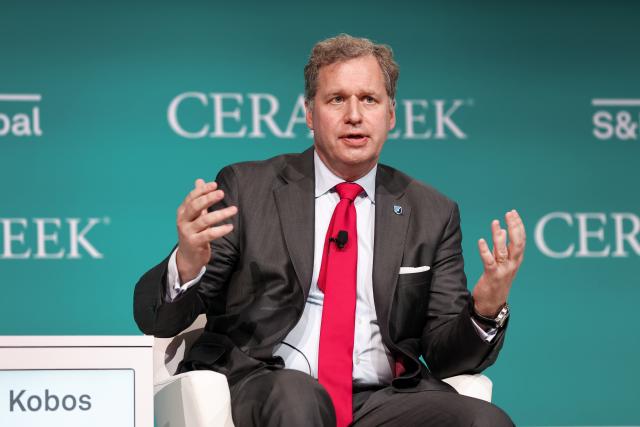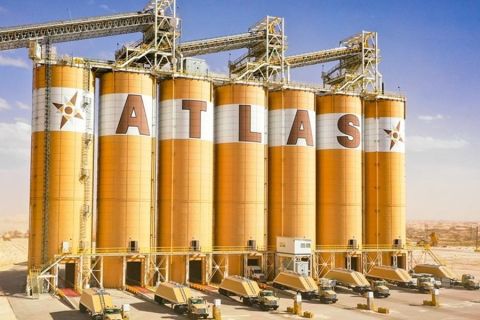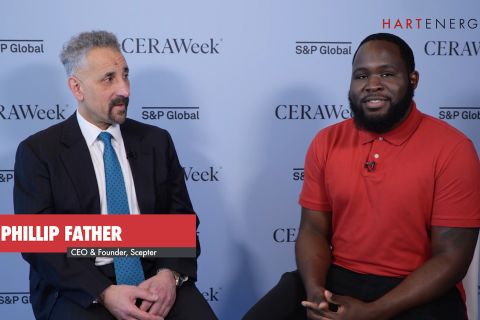
Excelerate Energy CEO Steven Kobos speaks during CERAWeek by S&P Global. (Source: CERAWeek by S&P Global)
Excelerate Energy’s CEO Steven Kobos spoke with Pietro D. Pitts, Hart Energy’s international managing editor, on March 9 at CERAWeek by S&P Global. Kobos, whose company boasts the world’s largest portfolio of floating LNG terminals, discussed how the LNG industry has adapted to war and commodity price volatility and what lies ahead for Europe, in particular. Europe’s gas storage levels following a mild winter are better than expected, but a challenge remains in refilling without the “benefit of six months of Russian gas.”
Kobos also addressed fuel switching caused by the Russia-Ukraine conflict and ways to help emerging economies avoid the “temptation to pivot to coal.”
He also addressed the vitality and havoc that outages can create — most prominently the disruptions at Freeport LNG’s Texas facility that can lead to volatility beyond what anyone expected. “For the next few years, more so than ever, any anticipated disruptions will have a bigger impact on volatility,” he said.
And Kobos weighed in possible demand destruction and what he sees as as the biggest potential outlier for natural gas in 2023: China.
Pietro D Pitts: What is your outlook for the LNG industry amid Shell Plc’s forecast which envisions a large gas supply gap to fill?
Steven Kobos: [There’s] obviously not a lot of new production coming online; it's rather flat. You’ve pointed out the key distinction to last year is China, and there are a few distinctions obviously. Europe’s starting from a much better place than before [and] they're likely going to end the winter at 60% storage, give or take. However, they won't have that benefit of six months of Russian gas that they saw in 2022. Europe is obviously using flexible import infrastructure, added to their capacity and their ability to receive LNG when needed without the bottlenecks you saw last year. [Also], their logistics are going to improve on getting volumes into Northern Europe, which is another positive. All told, Europe did push some other buyers out of the market when prices reached the levels that they did last summer. We clearly see prices [have] come down and I'm really pleased because you see countries like Bangladesh reentering the spot market. They've just gone out with four different spot cargo tenders. It's not an ideal price for non-OECD markets, but it's at least something they can afford and it's competitive with other fuels.
RELATED
Shell CEO Confident on Long-Term LNG Demand
PDP: The start of the Russia-Ukraine conflict last year led to a lot of fuel switching. How do you see that playing out this year amid lower gas prices?
SK: I think this past year what we saw was fuel switching. And of course, we're all concerned from an energy transition point that prolonged fuel switching could, in fact, lead to long-term demand destruction. However, we don't personally see that yet. Many of these countries already have good gas infrastructure. The countries that are moving to coal — there are some countries like India that's 80% of coal fired power generation — they've already made that move, they've built that infrastructure. Provided prices can moderate, I don't see a lot of the non-OECD countries pushing backward to coal.
But that's the challenge that we all have. We need to get LNG into these non-OECD markets, support their economies and induce them to avoid the temptation to pivot to coal. I don't think we have demand destruction for gas or LNG yet. It's just something that we need to manage carefully the next couple of years, and those non-OECD countries recognize they need to contract long term for LNG. They were doing well for years optimizing by having significant spot volumes. But I think they've seen the cost of optimizing through heavy use of spot when things go pear-shaped is not a good outcome. So I think you will see non-OECD markets seeking more long term contracting of LNG as the next production waves come on.
PDP: How do you view talk about Europeans not wanting to lock into long-term gas contracts while the Asians are seemingly willing to do so?
SK: We've obviously moved some of our infrastructure into Europe [and] we've been selling some cargoes through Finland and our Finnish gas marketing subsidiary. We don't believe there's one strategy that's right for everyone. So frankly, whether Europe would like medium or longer term volumes or some spot, we'd like to accommodate that through our flexible infrastructure. That’s the narrative but you also hear different things out of Europe about their appetite for longer term.
PDP: What did the Freeport LNG outage last year tell us about the LNG market’s ability to react under those circumstances? Could that could trigger the US to move quicker to push forward LNG projects?
SK: I don't know if it's the driver in of itself, but, that’s my concern. We've seen that single disruptions can lead to enhance volatility beyond what people expected. And we do need to be mindful of that, especially as you pointed out for the next couple of years as we have a fairly tight supply demand balance.
PDP: What are you hearing about the pace of the Russia-Ukraine war and how that's going to continue to impact Europe’s energy demand?
SK: We think that flexible energy infrastructure is part of the long-term answer for Europe, regardless if Europe wants to flow lots of LNG through those terminals. … The takeaway is it was unfortunate that there wasn't an alternative infrastructure at the outset. That being said, you have to congratulate the Europeans on how quickly they've executed, sometimes going from contract signing to importing volumes in 200 days. That's about what the Finland terminal that we worked on did. And that's been matched at other locations in Europe. And it's impressive.
RELATED
Germany’s Wilhelmshaven Terminal Receives First US LNG Cargo
PDP: Europe’s made it through its first winter amid the Russia-Ukraine war. What is Europe’s ability to get through next winter considering what many countries are doing to procure new gas supply?
SK: Anyone with a fragile energy system like this should be concerned. The Europeans are [worried and] I don't see anyone being cavalier about the challenges in front of them. At the same time, they saw they could enter the market and buy what they needed if they had to. So they must feel good about that. But I don't see anyone letting their guard down or just taking the future for granted just because they had a warm winter.
PDP: What’s your view on European companies tapping more gas supply from Africa. Is that also a good source that Europe should pursue?
SK: The solution for Europe is multifaceted. Obviously, it’s maximizing pipe deliveries from Africa, maximizing pipe deliveries from Norway and it has to be an all of the above strategy. There's no doubt that rapid deployment of floating import infrastructure like Excelerates’ is going to be one of the key differentiators. The pipeline capacity is what is has been [and] the import terminals are what've been added to the equation. If they can maximize further pipeline deliveries through existing infrastructure, that's fantastic. But the real upside has to come through LNG.
PDP: Is the ship building side of the LNG equation on pace with new developments in the U.S., Qatar and beyond?
SK: I'm focused on our own particular needs and we have new FSRU [floating storage and regasification units] under construction with Hyundai. So we're pleased with where we are for our own building program. In general, you've seen the real drivers in the shipyard program [related to Qatar and its] expansion of the North Field and the tonnage required for that is taking up a lot of shipyard capacity, and the U.S. FIDs [final investment decision] are stacking on top of that. At the same time, at least in the past few years, you've seen Japanese yards depart the space, [and] I’m not sure if that's permanent or temporary phenomenon. you see more reliance on the Korean yards than you might have seen in the past compared to the total tonnage. I have confidence in them to continue to scale and to do what they need to do to deliver a fantastic product. Our fleet is all Korean built and we've always been happy with their ability to deliver as promised.
RELATED
Venture Global, Excelerate Ink 20-year LNG Deal
PDP: With an abundance of gas supply in the U.S., are you concerned about the U.S.’ ability to supply the various planned export LNG plants in Mexico?
SK: In our business, we want to see more LNG on the market. Obviously, we want there to be as much out there as possible because we want to be the point of interconnection that allows a new market to receive it. We're advantaged as much as the LNG industry can succeed. In turn, the LNG industry is helped when actors like Excelerate can open new markets that have not been consumers in the past. So we clearly have a symbiotic relationship with LNG in general, [and] each project has its own challenges.
PDP: Excelerate has been in Argentina for well over a decade. Recently, the Neuquén Energy Minister Alejandro Rodrigo Monteiro told me he doesn’t expect Argentina to ‘bring on LNG in magnitude’ before 2028 to 2030. What’s your view on Argentina?
SK: We've had very good experience in Argentina that whole time. It's a complex energy system. We were happy to be a part of that for however long that they need it. There are other pressures coming to bear in the region [and] if we're talking about Argentina and Brazil, we have to talk about Bolivia and what the potential curtailment of those gas volumes means for others and for energy security. The Southern Cone is going to need energy security for some time, regardless of the production in the south.
RELATED
Exclusive Q&A: The Future of Argentina’s Vaca Muerta Shale and LNG
PDP: Argentina is looking to import around 30 cargoes this year. What does that tell you about the LNG industry and the Argentine’s ability to find cargoes?
SK: We're interested in anything Argentina does relative to LNG, and helping them succeed in their plans. The real point that I’d emphasize about Argentina in those 30 cargoes is, a year ago or last summer, people would have suggested that a country like Argentina wouldn’t be able to compete with Europe. And here we see somebody coming in and competing very effectively and obtaining all of the LNG they need. So there's really more of a headline there on what Argentina has achieved with those cargoes.
PDP: What should we keep our eyes on in 2023?
SK: That would be some unexpected or disruptive event, whether that's a Freeport, whether that's some unanticipated direction the war takes in Ukraine or really we're all talking about Chinese demand coming back on, that can be an enormous driver. They have a lot of alternatives and often behave in a purely mercantile way in terms of pricing, which was good for the rest of the world last year [related to] fuel switching and opting to sell cargoes into Europe that they perhaps didn’t have to, so that softened the impact. What happens with Chinese demand is the single biggest outlier for 2023.
Recommended Reading
Fire Closes Atlas Energy’s Kermit, Texas Mining Facility
2024-04-15 - Atlas Energy Solutions said no injuries were reported and the closing of the mine would not affect services to the company’s Permian Basin customers.
Coalition Launches Decarbonization Program in Major US Cities, Counties
2024-04-11 - A national coalition will start decarbonization efforts in nine U.S. cities and counties following a federal award of $20 billion “green bank” grants.
Exclusive: Scepter CEO: Methane Emissions Detection Saves on Cost
2024-04-08 - Methane emissions detection saves on cost and "can pay for itself," Scepter CEO Phillip Father says in this Hart Energy exclusive interview.
Majority of Recent CO2 Emissions Linked to 57 Producers - Report
2024-04-03 - The world's top three CO2-emitting companies in the period were state-owned oil firm Saudi Aramco, Russia's state-owned energy giant Gazprom and state-owned producer Coal India, the report said.




